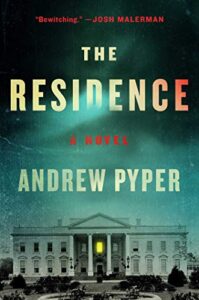A note from the editor:
We are more than midway through October and Monster Librarian still needs to raise the funds to pay for our hosting fees and postage in 2021. If you like what we’re doing, please take a moment to click on that red “Contribute” button in the sidebar to the right, to help us keep going! Even five dollars will get us closer to the $195 we need to keep going at the most basic level. We have never accepted paid advertising so you can be guaranteed that our reviews are objective. We’ve been reviewing and supporting the horror community for 15 years now, help us make it another year! Thank you! And now, David Simms reviews The Residence by Andrew Pyper.
The Residence by Andrew Pyper ( Bookshop.org | Amazon.com )
Simon & Schuster, 2020
ISBN-13 : 978-1982147365
Available: Hardcover, paperback, Kindle edition, compact disc, audiobook
Historical horror can be a mixed bag. The immediacy of the terror tends to be removed in a period piece, while dialogue and characterizations, not to mention obsolete settings, can deflate any true scares or dread from the tale at hand, no matter how well it is written.
However, The Residence rises above these obstacles to take up, well, residence, in the reader’s head. It’s in the vein of The Hunger or The Terror, both of which are recent landmarks in the genre.
Andrew Pyper knows how to deliver the horror in a novel. His Demonologist rivaled the best possession stories, and his other titles have been entertaining, chilling books.
This time out, Pyper ventures into terrifying territory– the White House. No, not the current administration. but that of Franklin Pierce, the 14th president of the United States. Pierce stars as a reluctant leader, one not expected to win, but turns out to be a popular man amongst his fellow Americans. A Democrat, he takes on the task of hoping to mend a divided nation. Pyper transports the reader back to 1853, when Pierce and his family are headed to Washington for the inauguration. Pierce’s wife, Jane, senses that the move might not help them, especially after she and Franklin have already lost two sons.
Eleven-year old Bennie is excited to stand beside his father at the ceremony and live the dream of any young boy, but the train, and possibly external forces, literally derail any hope of happiness for the Pierce family during his presidency. At the bottom of the ravine, only one casualty is found– Bennie.
Grieving the loss of her son, Jane escapes into herself, building herself a “grief room” within the White House, and refuses any duties of a First Lady. Instead, she calls for a pair of psychics, the Fox sisters, to help communicate with Bennie. and salvage any hope she has for remaining in the land of the living.
What they achieve, though, invites something far more sinister: something that becomes a paranormal entity in the capital that threatens to destroy much more than the Pierce family.
Pyper sidesteps any pitfalls that could undermine the horror in this tight, family-centered story that is closely tied to actual history. The White House is reported to be haunted, by several spirits, and much of what is spun here actually occurred. Pyper doesn’t allow himself to become bogged down with an excess of period details or historical overload, rather focusing on the hauntings and how what is unleashed threatens to destroy the Pierces– and much more. Recommended.
Reviewed by David Simms







Follow Us!